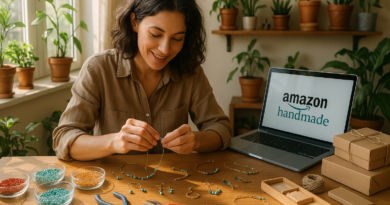Strategic Partnerships for Artisans: Expanding Your Reach and Growing Your Business
Every artisan knows how challenging it is to turn talent into consistent income. Creating unique pieces takes time, dedication, and passion. But when it comes to selling and growing, many face difficulties due to a lack of visibility, structure, or support. This is where strategic partnerships for artisans come in — a practical and powerful way to expand your audience, strengthen your brand, and scale your business sustainably.
Contrary to what many think, forming partnerships doesn’t mean depending on others. On the contrary: it’s about joining forces with those who complement your skills, know other markets, or can help with promotion and sales. Whether with other artisans, shopkeepers, influencers, or even companies, strategic partnerships create connections that bring value to everyone involved.
More than a trend, this collaboration model has become a necessity for those who want to compete in an increasingly demanding market. The good news is that these partnerships don’t require large investments — just vision, planning, and a willingness to cooperate. In this article, we’ll show how you can apply this concept in practice and turn your artisan work into an even stronger business.
1. Identify partners who add value
The first step in forming strategic partnerships for artisans is knowing who is worth connecting with. Look for people or businesses that share your values and work in areas that complement yours. For example, if you work with handmade jewelry, a partnership with an independent clothing store might be interesting. Someone who works with ceramics could partner with cafes or restaurants looking for exclusive pieces for serving or decor.
Make a list of potential partners inside and outside your city. Research on social media, attend fairs and local events, and talk to other entrepreneurs. Ask yourself: “What can I offer this partnership?” and “What can this partnership offer me in return?” This exchange needs to be fair to work.
Avoid generic pitches. Personalize your proposal by showing that you know the person’s work and suggesting a concrete idea for collaboration. It could be a joint project, mutual promotion, or even an exclusive collection created together.
2. Create purpose-driven collaborations
A strategic partnership only makes sense when there’s a real purpose. It’s no use joining forces just for commercial gain if there’s no alignment of ideas and goals. When the focus is on delivering value to the audience, the results come naturally.
A good example is creating custom kits or bundles with other artisans. Imagine a gift set with a handmade candle, a natural soap, and a small ceramic piece — all made by different people, but with similar aesthetics and proposals. Besides adding value to the product, it also divides production, packaging, and promotion costs among the partners.
Another valid idea is to develop exclusive products for a partner’s specific audience. A sewing studio can create limited pieces with prints from a local visual artist. A woodworker can craft custom stands for another artisan’s paintings or embroidery. The more creative and authentic the collaboration, the more likely it is to make an impact.
3. Use digital tools to your advantage
Today, the internet is an essential ally in expanding the reach of strategic partnerships for artisans. Platforms like Instagram, WhatsApp, YouTube, and even TikTok allow you to create collaborative content, show behind-the-scenes production, and attract new audiences organically.
You can, for example, do a live stream with a partner to talk about topics in the artisan world, show a “DIY” using both products, or promote a joint launch. Besides humanizing your brand, this increases engagement and builds audience trust.
Another valuable tip is to join collective marketplaces or create a shared online store with other artisans. This makes logistics easier, reduces costs, and creates a stronger storefront. If possible, invest in good photos, clear descriptions, and personalized customer service — attention to detail also communicates the value of your work.
4. How to start your first partnership: step by step
If you’ve never done a strategic partnership and don’t know where to start, here’s a simple step-by-step guide:
- Define your goal – Do you want to sell more? Reach a wider audience? Create new products?
- List potential partners – Choose those with a style that aligns with yours and who can help you reach your goal.
- Create a clear proposal – Think of something that benefits both sides.
- Reach out with empathy – Be direct, kind, and show genuine interest in the other person’s work.
- Formalize simple agreements – It can be an informal contract, but it’s good to have everything written down.
- Promote together – Use both of your social media channels to promote the project or product.
- Evaluate the results – After a while, assess what worked and what can be improved for future partnerships.
5. Trust, communication, and real results
In the end, the success of strategic partnerships for artisans depends on trust between those involved. Successful partnerships are built with communication, respect for each other’s limitations, and clarity about responsibilities. Don’t be afraid to adjust, renegotiate, or end something that’s not working.
More than increasing sales, good partnerships generate learning, strengthen local networks, and help build a fairer and more creative ecosystem for everyone who lives off handmade art. When collaboration is genuine, growth comes as a natural consequence.
Believe this: no one grows alone. And in the world of handmade crafts, walking together can be the difference your business needs to reach new heights.



